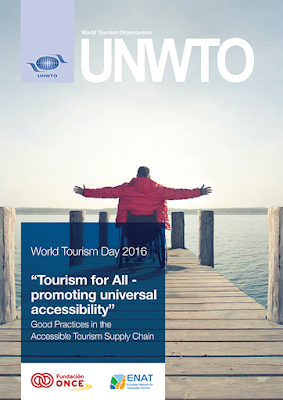Dear colleagues,
United Nations World Tourism Organisation (UNWTO) has been celebrating the World Tourism Day (WTD) on September 27 since the year 1980. The statue of UNWTO was adopted on 27th September 1970 which is considered as a milestone in global tourism.
WTD is celebrated every year to raise awareness on the role of tourism within the international community and to demonstrate how it affects social, cultural, political and economic values worldwide. Universal Access in Tourism (UAT) responds to Article 2.2 of the UNWTO’s Global Code of Ethics for Tourism which states: “Tourism activities should respect the equality of men and women in that they should promote human rights and, more particularly, the individual rights of the most vulnerable groups, notably children, the elderly, the handicapped, ethnic minorities and indigenous people.”
UNWTO has decided to have the theme of #WTD2016 as Tourism for All - Promoting Universal Accessibility. The celebration of the World Tourism Day 2016 under the above theme comes at an encouraging time for international tourism as more political decision makers and the tourism industry are advocating for tourism for all, a tourism which can be enjoyed equally by everybody, regardless of one’s age or abilities. The event seeks to address global challenges outlined in the United Nations Millennium Development Goals (MDGs) and to highlight the contribution the tourism sector can make in reaching these goals.
Reiterating the need of accessibility for all, the United Nations Secretary-General, Ban Ki-Moon, in his official message on World Tourism Day said, "Everyone has the right to access leisure and tourism services on an equal basis. Yet one billion people around the world living with disability, along with young children, seniors and persons with other access requirement, face obstacles in accessing fundamentals of travel such as clear and reliable information, efficient transportation and public services, and a physical environment that is easy to navigate. Even with modern technologies, those with visual, hearing, mobility or cognitive impairments are being left behind in many tourism destinations."
India has 32 UNESCO recognised World Heritage Sites (WHS), which generate important revenues due to the large numbers of both domestic and international tourists. In the recent years, India has been focusing on making its tourism products and services accessible to all particularly the tourists with disabilities, seniors, children & women. Archaeological Survey of India is partnering with non-profits & other stakeholders to ensure that sensitive cultural monuments are adapted without damaging the unique heritage character of the monument yet, these become visitable by all on an equal basis with others. Of these, WHS like Qutb Minar & Red Fort in Delhi and Fatehpur Sikri in Agra have won National Tourism Awards for being made accessible & disabled friendly in the past few years. Some other monuments are in the process.
Though the pace of enhancing accessibility in tourism products is not as per the rising aspirations of the stakeholders, however the nation is on right track.
Govt. of India under its Accessible India Campaign in partnership with Archaeological Survey of India, Ministry of Culture is planing to make major world heritage sites/ monuments accessible within a time bound manner, though the ASI have completed access improvements at some very promising projects on monuments under Delhi & Agra Circles. However, it needs to speed up the work. This is not just important to meet the legal mandate under the Persons with Disabilities Act 1995, UN Convention on the rights of persons with disabilities (UN CRPD) but also to attract a huge chunk of the section of potential tourists that has some or the other form of disability. Many countries have achieved remarkable access improvements while India is still struggling due to inherent challenges. But there is hope - a hope for better accessibility at tourism sites so that persons with disabilities could also enjoy their rights to recreation, leisure and culture on an equal basis with others as enshrined in Article 30 of the CRPD.
On this World Tourism Day, we commit ourselves to make Indian Tourism sites & services welcoming to all with a greater vigour.


